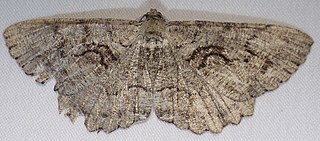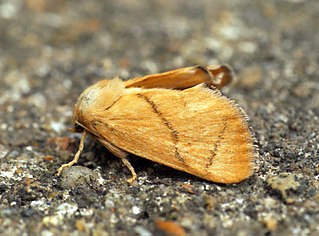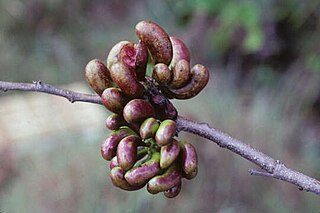
Gnophaela is a genus of tiger moths in the family Erebidae. The genus was erected by Francis Walker in 1854.
Kodiosoma is a monotypic moth genus in the family Erebidae. Its only species, Kodiosoma fulvum, is found in Arizona, Nevada and California. Both the genus and species were described by Richard Harper Stretch in 1872.

Leptarctia is a monotypic tiger moth genus in the family Erebidae described by Stretch in 1872. Its only species, Leptarctia californiae, was described by Francis Walker in 1855. It is found in western North America, from New Mexico and Colorado to California and north to British Columbia. The habitat consists of open forests, meadows and clearings in the mountains.

Spilosoma is a genus of moths in the family Erebidae originally described by John Curtis in 1825. A very heterogeneous group, it is in need of review by the scientific community, as certain species probably need reclassification into their own genera.

Cymatophora is a genus of moths in the family Geometridae erected by Jacob Hübner in 1812. It is monotypic, being represented by the single species, the giant gray moth. It is found mostly in the south-eastern United States. It is found in North America.

Dyspteris is a genus of moths in the family Geometridae and was erected by Jacob Hübner in 1818. It is monotypic, being represented by a single species, Dyspteris abortivaria, commonly known as the bad-wing. This species was first described by Gottlieb August Wilhelm Herrich-Schäffer in 1855 and is found in North America.
Eumacrodes is a monotypic moth genus in the family Geometridae described by Warren in 1905. Its only species, Eumacrodes yponomeutaria, first described by Achille Guenée in 1858, is found in the Caribbean and North America.

Hemimorina is a monotypic moth genus in the family Geometridae. Its only species, Hemimorina dissociata, is found in North America. Both the genus and species were first described by James Halliday McDunnough in 1941.

Odontoptila is a monotypic moth genus in the family Geometridae described by Warren in 1897. Its only species, Odontoptila obrimo, was first described by Druce in 1892. It is found in Central and North America.
Paota is a monotypic moth genus in the family Geometridae described by George Duryea Hulst in 1896. Its only species, Paota fultaria, was first described by Augustus Radcliffe Grote in 1882. It is found in North America.
Ptychamalia is a monotypic moth genus in the family Geometridae described by Prout in 1932. Its only species, Ptychamalia dorneraria, was first described by William Barnes and James Halliday McDunnough in 1913. It is found in North America.

Catocala junctura, the joined underwing or Stretch's underwing, is a moth in the family Erebidae. The species was first described by Francis Walker in 1858. It is found throughout temperate North America, ranging from New York and Pennsylvania west to Montana, Colorado, Oklahoma, Arizona, and into Texas, and north to southern Illinois, extreme southern Alberta and Saskatchewan; it has also been recorded west of the Rocky Mountains from California and south-eastern British Columbia. It is typically found near water, where the food plants of its caterpillar larvae grow plentifully.

Gnophaela vermiculata, sometimes known as the police-car moth or green lattice, is a moth of the family Erebidae. The species was first described by Augustus Radcliffe Grote in 1864. It is found in the Rocky Mountain region of the United States and in western parts of North America, from British Columbia to California, east to New Mexico and north to Manitoba.

The Pericopina is a subtribe of tiger moths in the family Erebidae. The subtribe was described by Francis Walker in 1869.
Gnophaela aequinoctialis is a moth of the family Erebidae. It was first described by Francis Walker in 1854 and is found in Texas, Mexico, Nicaragua and Venezuela.

Gnophaela latipennis, the wild forget-me-not moth, is a moth of the family Erebidae. It was described by Jean Baptiste Boisduval in 1852. It is found in the US states of Oregon and California. The habitat consists of open mixed hardwood-conifer forests, oak woodlands and open riparian areas near creeks, as well as in open ponderosa pine forests and mountain meadows.
Gnophaela clappiana is a moth of the family Erebidae. It was described by William Jacob Holland in 1891. It is found in the United States from Arizona and New Mexico to Colorado.

Apoda is a genus of slug caterpillar moths in the family Limacodidae. There are about 10 described species in Apoda.

Xylopia discreta is a species of plant in the Annonaceae family. It is native to Brazil, Colombia, French Guiana, Guyana, Suriname, and Venezuela. Carl Linnaeus the Younger, the botanist who first formally described the species using the basionym Unona discreta, named it after its purple, aromatic fruit which set it apart from other members of the family.











